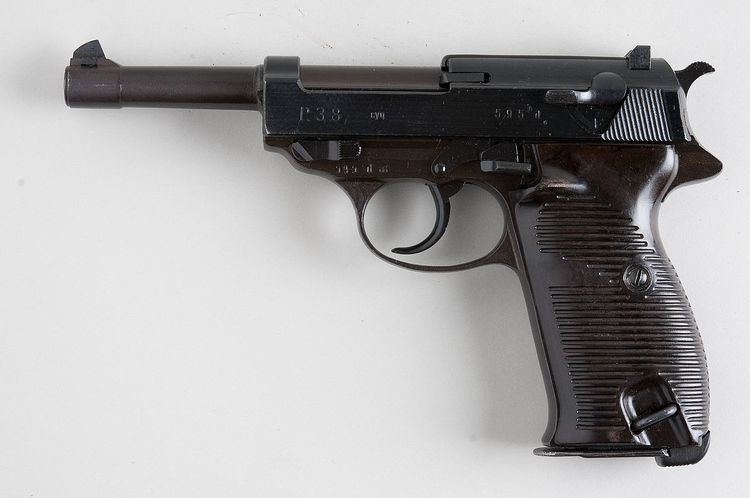In service 1938–present Designed 1938 | Used by See Users | |
 | ||
Wars World War IIPortuguese Colonial War | ||
The Walther P38 is a 9 mm semi-automatic pistol that was developed by Walther arms as the service pistol of the Wehrmacht at the beginning of World War II. It was intended to replace the costly Luger P08, the production of which was scheduled to end in 1942.
Contents
Development
The first designs submitted to the German Army featured a locked breech and a hidden hammer, but the Heer (German Army) requested that it be redesigned with an external hammer.
The P38 concept was accepted by the German military in 1938 but production of actual prototype ("Test") pistols did not begin until late 1939. Walther began manufacture at their plant in Zella-Mehlis and produced three series of "Test" pistols, designated by a "0" prefix to the serial number. The third series pistols satisfactorily solved the previous problems for the Heer and mass production began in mid-1940, using Walther's military production identification code "480". After a few thousand pistols the Heer changed all codes from numbers to letters and Walther was given the "ac" code.
Several experimental versions were later created in .45 ACP, and .38 Super, but these were never mass-produced. In addition to the 9×19mm Parabellum version, some 7.65×21mm Parabellum and some .22 Long Rifle versions were also manufactured and sold.
Design details
From an engineering perspective the P38 was a semi-automatic pistol design that introduced technical features that are found in other semi-automatic pistols like the Beretta 92 and its M9 sub-variant adopted by the United States military.
The P38 was the first locked-breech pistol to use a double-action/single-action (DA/SA) trigger (the earlier double-action PPK was an unlocked blowback design, but the more powerful 9x19mm Parabellum round used in the P38 mandated a locked breech design). The shooter could chamber a round, use the safety-decocking lever to safely lower the hammer without firing the round, and carry the weapon loaded. This lever can stay down, keeping the pistol "on safe" or be immediately returned to the straight position, keeping the weapon safely "ready" with a double-action trigger pull for the first shot. Pulling the trigger cocks the hammer before firing the first shot with double-action operation. The firing mechanism extracts and ejects the first spent round, cocks the hammer, and chambers a fresh round for single-action operation with each subsequent shot - all features found in many modern day handguns. Besides a DA/SA trigger design similar to that of the earlier Walther PPKs the P38 featured a visible and tactile loaded chamber indicator in the form of a metal rod that protrudes out of the top rear end of the slide when a round is present in the chamber.
The moving-barrel design mechanism operates by use of a wedge-shaped falling locking block underneath the breech. When the pistol is fired both the barrel and slide recoil for a short distance together, where the locking block drives down, disengaging the slide and arresting further rearward movement of the barrel. The slide however continues its rearward movement on the frame, ejecting the spent case and cocking the hammer before reaching the end of travel. Two return springs located on either side of the frame and below the slide, having been compressed by the slide's rearward movement, drive the slide forward, stripping a new round from the magazine, driving it into the breech and, in the process, re-engaging the barrel; ending its return travel with a fresh round chambered, hammer cocked and ready to repeat the process. The falling locking block design provides good accuracy due to the in-line travel of the barrel and slide.
Initial production P38 pistols were fitted with walnut grips, but these were later supplanted by Bakelite grips.
Variants
The Walther P38 was in production from 1938 to 1945. From 1945 to 1957, no P38s were produced for the German military. Slowly over time, West Germany desired to rebuild its military so that it could shoulder some of the burden for its own defense. Walther retooled for new P38 production since no military firearms production had occurred in West Germany since the end of the war, knowing that the military would again seek Walther firearms. When the Bundeswehr announced it wanted the P38 for its official service pistol, Walther readily resumed P38 production within just two years, using wartime pistols as models and new engineering drawings and machine tools. The first of the new P38s were delivered to the West German military in June 1957, some 17 years and two months after the pistol had initially seen action in World War II, and from 1957 to 1963 the P38 was again the standard sidearm.
In late 1963 the postwar military model P1 was adopted for use by the German military, identifiable by the P1 stamping on the slide. The postwar pistols, whether marked as P38 or P1, have an aluminum frame rather than the steel frame of the original design. The aluminum frame was later reinforced with a hex bolt above the trigger guard. During the 1990s the German military started replacing the P1 with the P8 pistol and finally phased out the P1 in 2004.
An improved version of the P38, the Walther P4, was developed in the late 1970s and was adopted by the police forces of South Africa, Rhineland-Palatinate and Baden-Württemberg.
